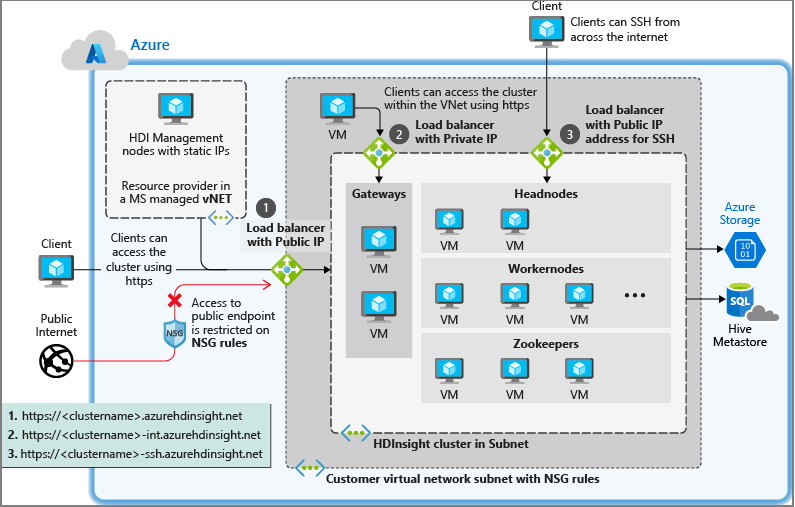Azure HDInsight virtual network architecture
This article explains the resources that are present when you deploy an HDInsight cluster into a custom Azure Virtual Network. This information helps you to connect on-premises resources to your HDInsight cluster in Azure. For more information on Azure Virtual Networks, see What is Azure Virtual Network?.
Resource types in Azure HDInsight clusters
Azure HDInsight clusters have different types of virtual machines, or nodes. Each node type plays a role in the operation of the system. The following table summarizes these node types and their roles in the cluster.
| Type | Description |
|---|---|
| ZooKeeper node | Zookeeper coordinates tasks between the nodes that are doing data processing. It also does leader election of the head node, and keeps track of which head node is running a specific master service. The number of ZooKeeper nodes is fixed at three. |
| Worker node | Represents the nodes that support data processing functionality. Worker nodes can be added or removed from the cluster to scale computing capability and manage costs. |
| Region node | For the HBase cluster type, the region node (also referred to as a Data Node) runs the Region Server. Region Servers serve and manage a portion of the data managed by HBase. Region nodes can be added or removed from the cluster to scale computing capability and manage costs. |
Resource naming conventions
Use Fully Qualified Domain Names (FQDNs) when addressing nodes in your cluster. You can get the FQDNs for various node types in your cluster using the Ambari API.
These FQDNs will be of the form <node-type-prefix><instance-number>-<abbreviated-clustername>.<unique-identifier>.cx.internal.cloudapp.net.
The <node-type-prefix> will be hn for headnodes, wn for worker nodes and zn for zookeeper nodes.
If you need just the host name, use only the first part of the FQDN: <node-type-prefix><instance-number>-<abbreviated-clustername>
Basic virtual network resources
The following diagram shows the placement of HDInsight nodes and network resources in Azure.

The default resources in an Azure Virtual Network include the cluster node types mentioned in the previous table. And network devices that support communication between the virtual network and outside networks.
The following table summarizes the nine cluster nodes created when HDInsight is deployed into a custom Azure Virtual Network.
| Resource type | Number present | Details |
|---|---|---|
| Head node | two | |
| Zookeeper node | three | |
| Worker node | two | This number can vary based on cluster configuration and scaling. A minimum of three worker nodes is needed for Apache Kafka. |
| Gateway node | two | Gateway nodes are Azure virtual machines that are created on Azure, but aren't visible in your subscription. Contact support if you need to reboot these nodes. |
The following network resources present are automatically created inside the virtual network used with HDInsight:
| Networking resource | Number present | Details |
|---|---|---|
| Load balancer | three | |
| Network Interfaces | nine | This value is based on a normal cluster, where each node has its own network interface. The nine interfaces are for: two head nodes, three zookeeper nodes, two worker nodes, and two gateway nodes mentioned in the previous table. |
| Public IP Addresses | two |
Endpoints for connecting to HDInsight
You can access your HDInsight cluster in three ways:
- An HTTPS endpoint outside of the virtual network at
CLUSTERNAME.azurehdinsight.net. - An SSH endpoint for directly connecting to the headnode at
CLUSTERNAME-ssh.azurehdinsight.net. - An HTTPS endpoint within the virtual network
CLUSTERNAME-int.azurehdinsight.net. Notice the "-int" in this URL. This endpoint resolves to a private IP in that virtual network and isn't accessible from the public internet.
These three endpoints are each assigned a load balancer.
Public IP addresses are also provided to the two endpoints that allow connection from outside the virtual network.
- One public IP is assigned to the load balancer for the fully qualified domain name (FQDN) to use when connecting to the cluster from the internet
CLUSTERNAME.azurehdinsight.net. - The second public IP address is used for the SSH only domain name
CLUSTERNAME-ssh.azurehdinsight.net.